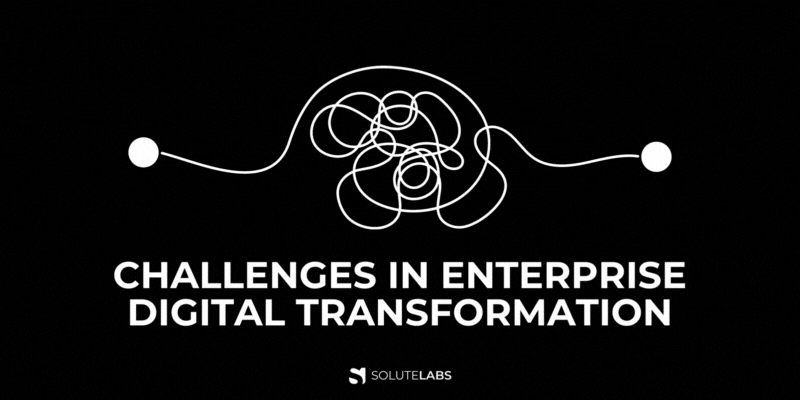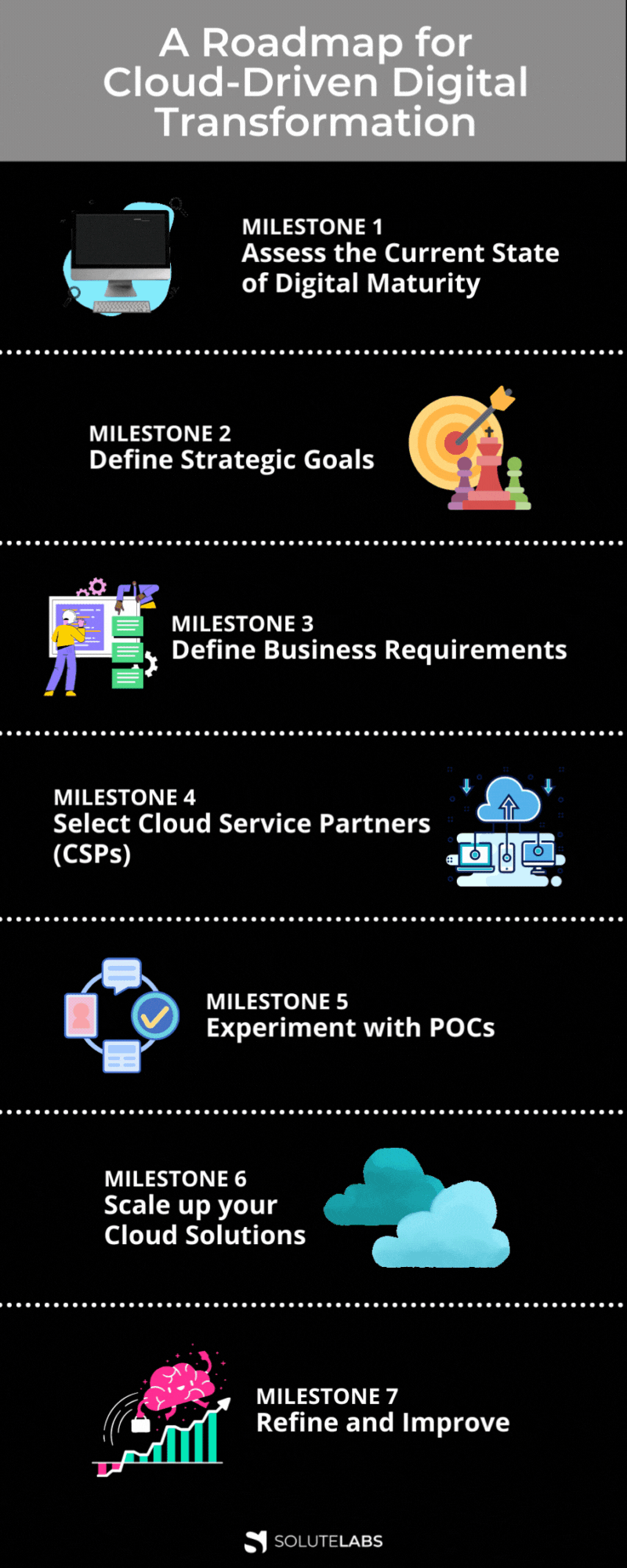How Cloud Adoption Accelerates Enterprise Digital Transformation?
Posted by Rajeev Vasani
24 Jan 23 • 9 Min read
The pandemic brought about a sea change in the way businesses operated. The work-from-anywhere (WFA) experiment necessitated by the pandemic offered unprecedented cost savings and continues to do so. Digital Marketplaces have become the norm, and online customer touchpoints have replaced conventional channels across industry verticals.
Over the last couple of years, it has become evident that enterprises that adapt rapidly to changing market conditions outperform their peers significantly. One of the key factors why some organizations stay ahead of the curve is their capability to leverage disruptive cloud technologies in an agile manner for transforming their businesses digitally.
What is Enterprise Digital Transformation?
Digital Transformation refers to an overarching set of strategic initiatives that leverage new technologies on an ongoing basis to redesign how an enterprise creates value for its customers, employees, and other stakeholders.
It is often confused with digitization and digitalization. Digitization is limited to converting physical data or documents into digital forms. It focuses on increasing efficiency and data durability.
Digitalization goes one step further and focuses on improving business processes using digital workflows. It focuses on improving the key performance indicators (KPIs) per the strategic objectives of an enterprise.
Digital Transformation encompasses both digitization and digitalization along with business and people aspects. It covers everything from implementing enterprise applications and creating digital work models to building new services for customers and employees. It focuses on creating a change in leadership mindset and organizational culture to leverage digital efficiencies continuously for growth.
Challenges in Enterprise Digital Transformation

1. Insufficient Financial Resources
Conventional IT projects require heavy capital investments. Setting-up on-premise infrastructure also entails hiring IT resources which is an additional operational expense.
2. Risk-Averse Company Culture
Many enterprises still consider digital investments as operational expenses rather than transformative initiatives. Since it is challenging to predict ROI for large digital projects, business leaders may be averse to taking the plunge.
3. Security Concerns
Enterprises may not want to store their proprietary or customer data outside their premise or network on a third-party platform.
4. Resistance To Change
Transformational projects may require changes in the business models, workplace dynamics, and operating procedures. A perception that potential IT solutions may not provide the necessary flexibility is one of the reasons digital transformation initiatives fail to take off.
How Does Cloud Adoption Help?

Cloud technologies are becoming the bedrock of transformation strategies for modern organizations. As per report by Fortune Business Insights, the global cloud computing market will grow from $480.04 billion in 2022 to $1,712.44 billion by 2029, at a CAGR of 19.9%.
Cloud tech offers several advantages over conventional on-premise IT setups that alleviate the challenges in digital transformation.
1. The Cloud Helps Scale Seamlessly.
As organizations grow, they do not need to worry about setting up additional hardware infrastructure and hiring IT resources to expand their digital capabilities. Cloud platforms are generally available on a monthly or yearly per-user subscription basis. Enterprises can buy additional licenses as their user base grows. The cloud service provider manages the servers, network components, and application updates in the background.
2. The Cloud is Customizable to Your Business Needs.
Cloud platforms lend the necessary agility required for digital transformation. IT teams can instantaneously increase or decrease storage and computing capacities based on enterprise needs. It allows businesses to try proof-of-concept (POC) or create new applications without hardware limitations or a slow procurement process.
Cloud-based software apps offer out-of-the-box functionalities aligned with industry best practices. However, you can also configure and customize these workflows for policies and models specific to your business. Also, these configurations do not require hi-tech IT resources. Business users can generally handle these on their own.
3. Cloud-Tech Offers Multi-Layer Data Security Measures.
Per a recent Deloitte Insights survey of more than 500 IT leaders, 58% of respondents ranked data security as the No. 1 or 2 reason for moving to the cloud. Modern cloud solutions employ the latest security protocols at every layer, from hardware and operating systems to application and user levels. Cloud tech protects your enterprise data in the face of sophisticated cyberattacks through regular malware and anti-virus scans. At the network level, it can block unwarranted and malicious traffic directed at draining your resources. You can also configure role-based access rights and automated audit trails to ensure accountability for data handling. Most importantly, the cloud infrastructure offers inbuilt business continuity protocols to ensure minimal data loss and downtime in case of major disasters.
4. Cloud Platforms Deliver Massive Cost-Savings.
Cloud tech operates on pay-as-you-use models. Enterprises save on upfront investments and IT personnel costs and also avoid overprovisioning. It reduces the financial risk involved in digital transformation projects and helps secure leadership buy-in. You can monitor for effective adoption and favorable business outcomes before scaling cloud applications to an enterprise level. This measured approach and the flexibility to scale down as required, has a direct positive impact on the organizational bottom line in the long run.
5. Cloud Platforms Help Build a Data-Driven Culture.
Cloud systems integrate easily with legacy enterprise systems and provide a secure, centralized store of clean data. Cloud infrastructure has also made the requisite computing power and analytical models accessible to enterprises of all sizes without heavy upfront investments. Artificial Intelligence (AI) driven analytical models, visual dashboards, and automated reports help formulate business strategies based on data. It is the hallmark of an organization on a digital transformation journey.
Different Approaches to Cloud Adoption
Mainly 3 types of cloud service models are there. Based on the level of flexibility and control you require, you can select one or a combination of them.
Infrastructure as a Service (IaaS)
Infrastructure as a Service (IaaS) offers on-demand access to IT infrastructure, including servers, storage, network components, and other virtual devices. It is similar to an on-premise set in that it provides a high level of control over your infrastructure but with the added benefit of increased flexibility and scalability.
Platform as a Service (PaaS)
Platform as a Service (PaaS) offers the hardware and software development resources you need for building your enterprise apps. You need not manage or maintain the underlying infrastructure. You can focus on building software as per your digital transformation needs.
Software as a Service (SaaS)
Software as a Service (SaaS) offers readily deployable end-user applications accessible over the internet. With SaaS, you do not need to manage or maintain the hardware or software resources. You can configure the application to your business needs with easy-to-use intuitive interfaces and deploy functionalities on the go.
From a network access perspective, cloud models are of three types - Public, Private, and Hybrid. A private cloud serves a single enterprise. A public cloud is a subscription-based online service that caters to multiple businesses. A combination of these two models is called a hybrid cloud.
A Roadmap for Cloud-Driven Digital Transformation
Following are the key milestones to be completed for digital transformation initiatives,

1. Assess the Current State of Digital Maturity
The first step is to assess your organization’s AS-IS digital business maturity and readiness for change. You must also understand the critical capabilities and competencies you need to build before embarking on the digital transformation journey.
2. Define Strategic Goals
Enterprises should set measurable and relevant goals for the TO-BE state. Identify your digital business ambition and determine how your enterprise will balance optimization and transformation objectives.
3. Define Business Requirements
The gaps you identify between the AS-IS and TO-BE states will form the basis for your cloud technology requirements. Track and learn about cloud disruptions and innovations in your industry vertical to refine your business requirements.
4. Select Cloud Service Partners (CSPs)
Seek strategic partnerships with cloud providers that align with your vision, and increase the speed and quality of your initiatives. Determine which cloud model - IaaS, PaaS, SaaS, or a combination - best serves your needs.
5. Experiment with POCs
Minimum Viable Proofs (MVPs) executed on the cloud enable you to understand the impact the transformation will have on your operations and the cultural changes required to succeed. It also allows you to measure KPIs and predict the effectiveness of the transformation initiative.
6. Scale up your Cloud Solutions
Create rollout plans and drive cloud adoption by actively engaging with your users. Communicate, clarify and coach for the business model changes required for cloud-based digital transformation success.
7. Refine and Improve
Monitor the environment to check whether the changes occur or when the changes happen that impacts your digital ambitions. Continuously monitor your digital business transformation strategy's impact on your organization, customers, and industry.
Conclusion
Per the Mckinsey ITaaS Survey, 75% of cloud migration projects go over budget with an average of 14% more annual spending than planned. Also, 38% of companies see migrations delayed by more than one quarter. It makes sense to onboard established partners with cloud deployment expertise to generate maximum ROI from your digital transformation initiatives. The availability of certified cloud engineers having experience across key CSPs like Amazon, Google, and Microsoft is a must for smooth cloud migration. It decreases the time to market and helps to maintain the momentum of your transformation journey.
SoluteLabs has expertise in Cloud Professional Services and is excited about taking your digital transformation project to the next level. Share your idea with us, and our team of cloud experts will help you achieve your desired results.
